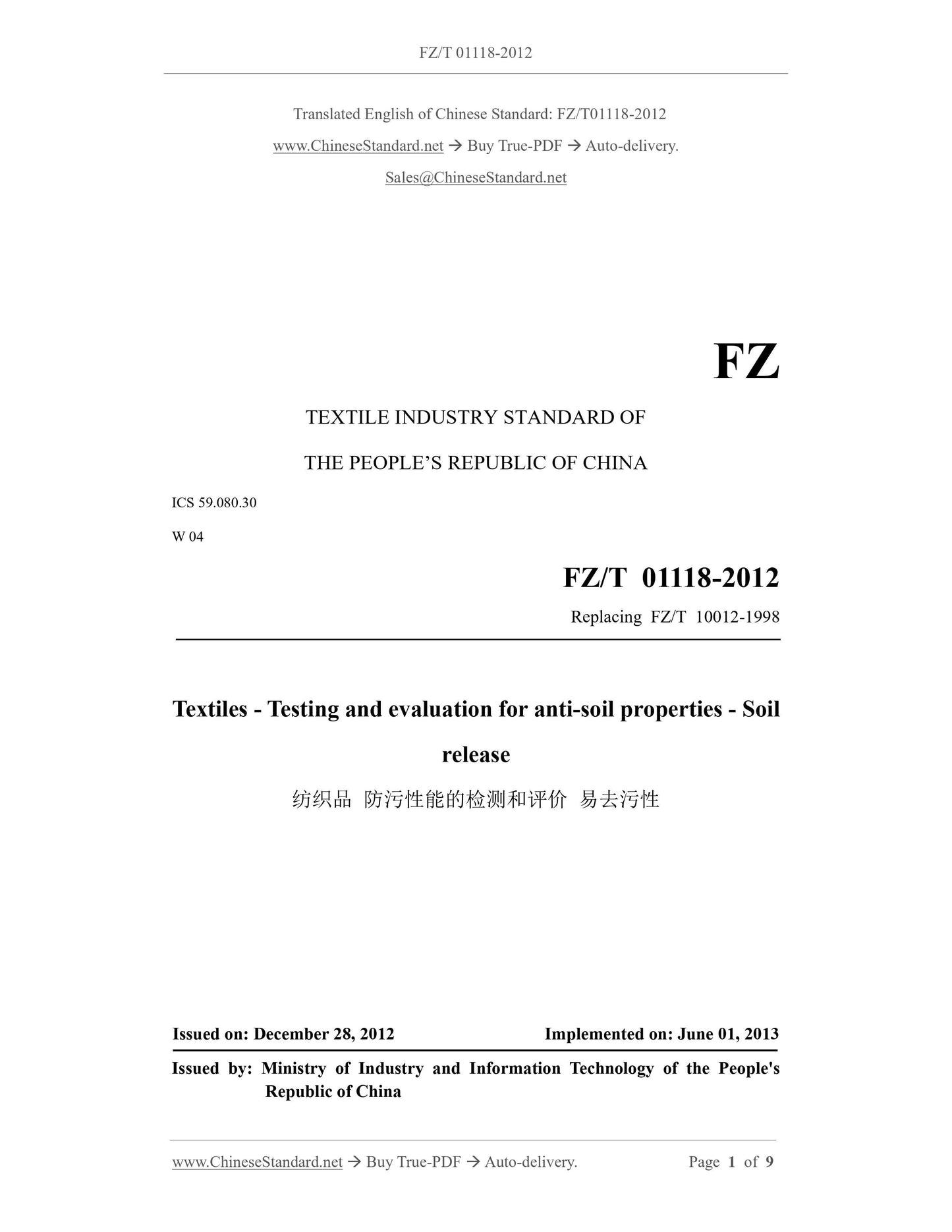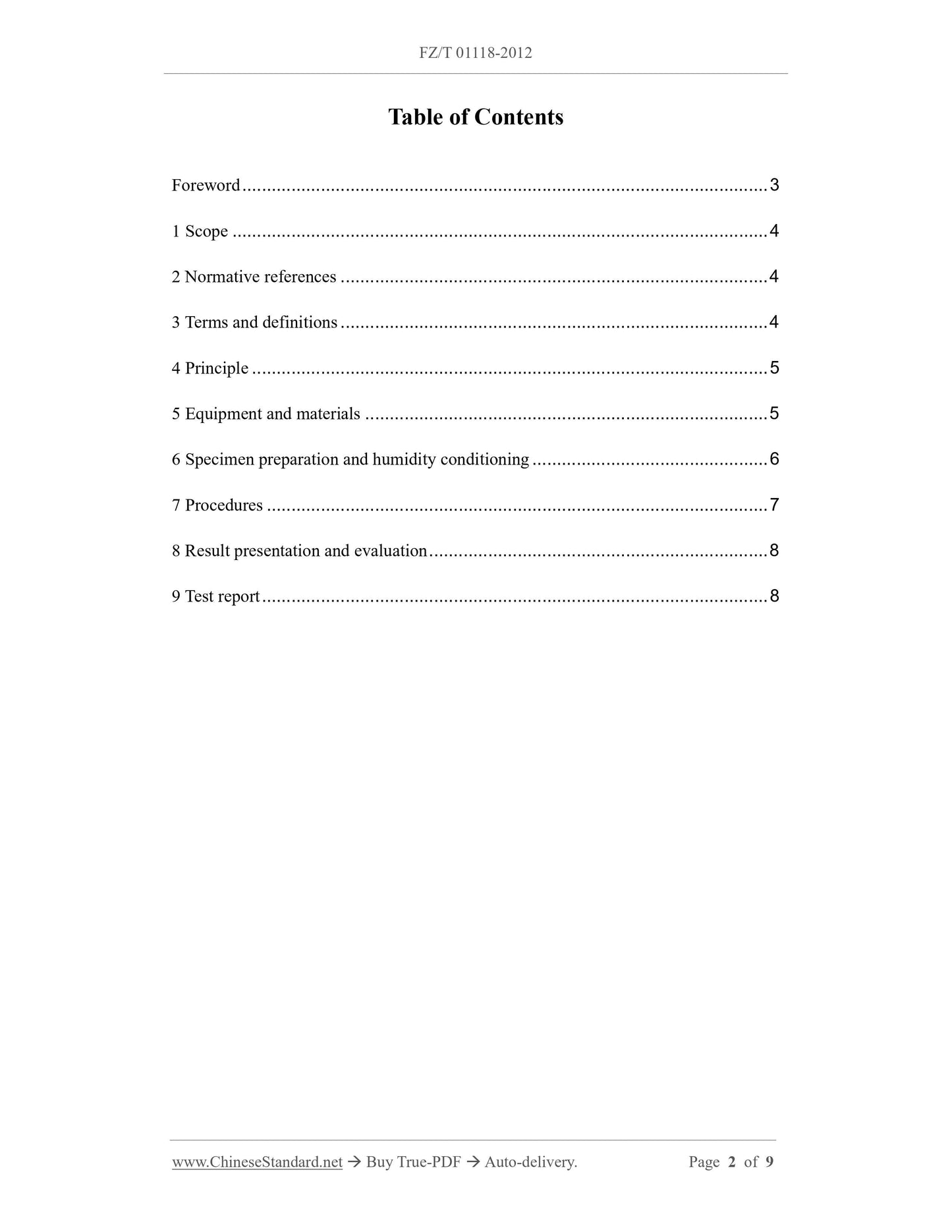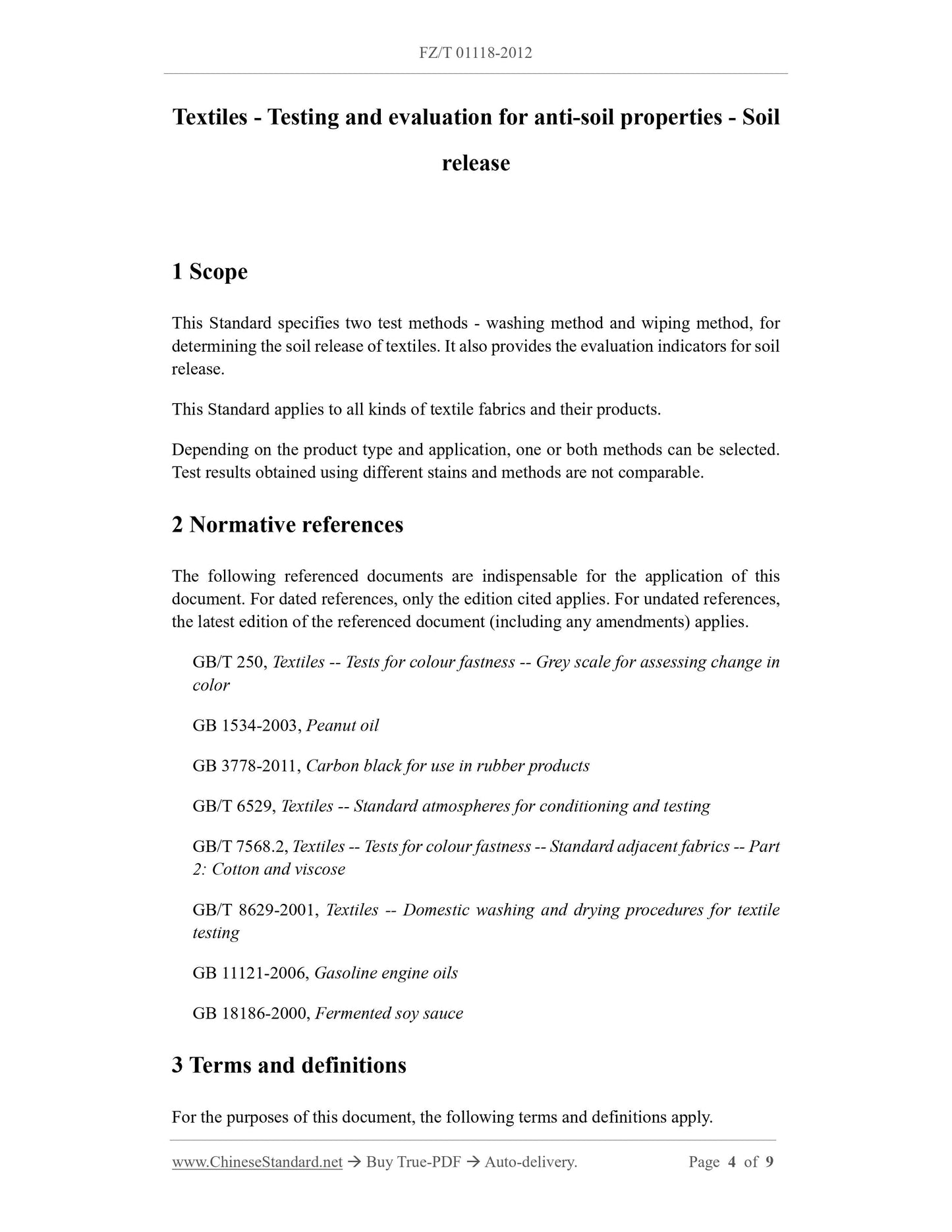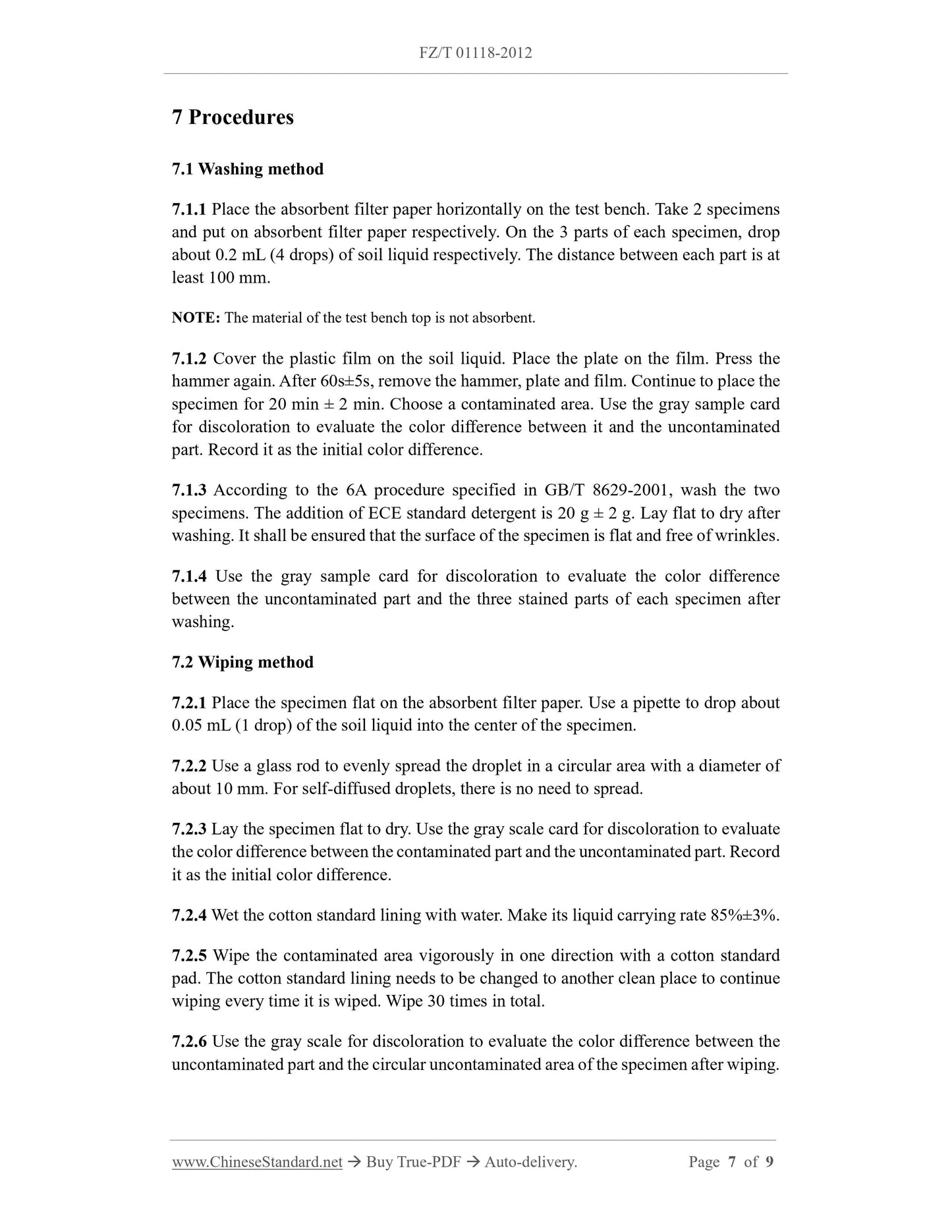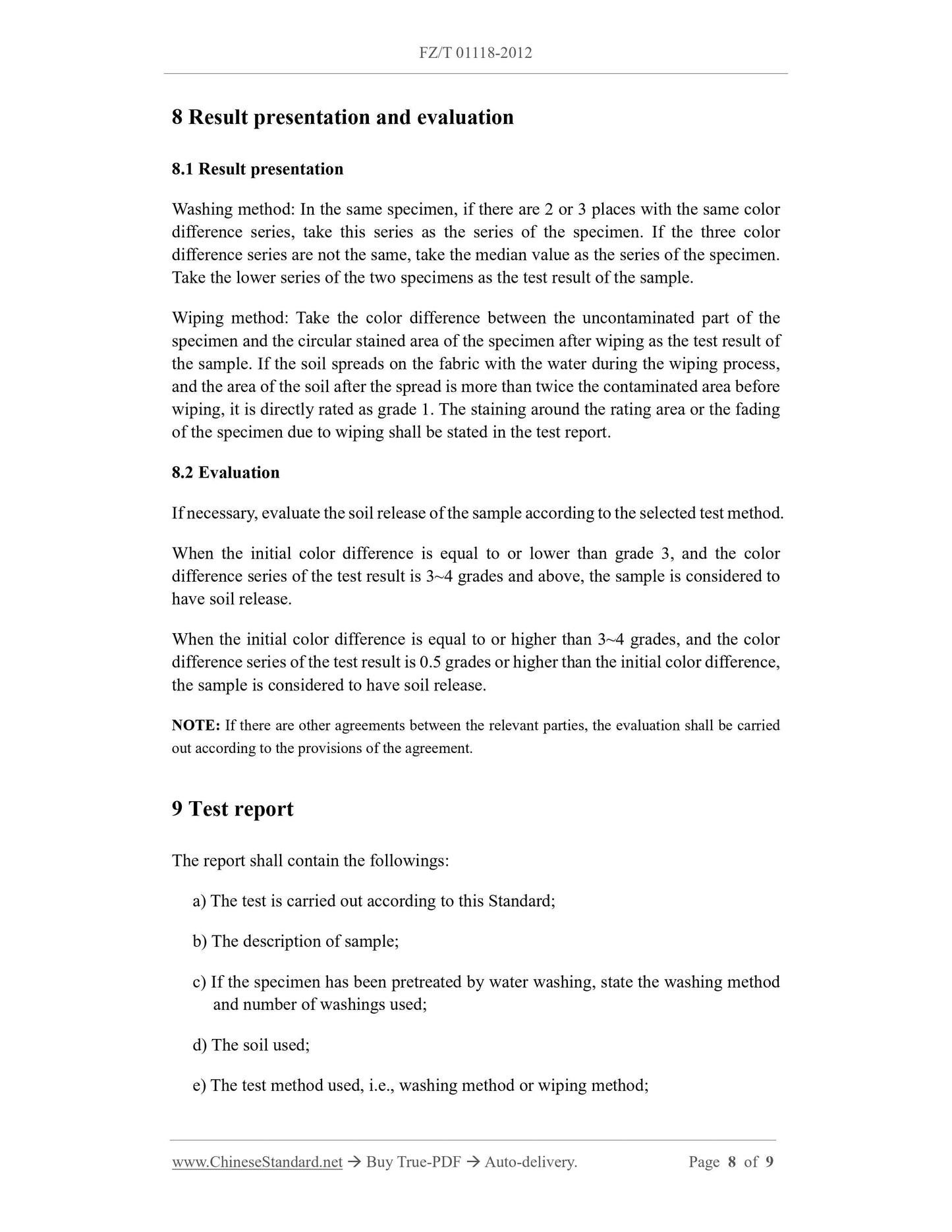PayPal, credit cards. Download editable-PDF and invoice in 1 second!
FZ/T 01118-2012 English PDF (FZT01118-2012)
FZ/T 01118-2012 English PDF (FZT01118-2012)
Precio habitual
$100.00 USD
Precio habitual
Precio de oferta
$100.00 USD
Precio unitario
/
por
Los gastos de envío se calculan en la pantalla de pago.
No se pudo cargar la disponibilidad de retiro
Delivery: 3 seconds. Download true-PDF + Invoice.
Get QUOTATION in 1-minute: Click FZ/T 01118-2012
Historical versions: FZ/T 01118-2012
Preview True-PDF (Reload/Scroll if blank)
FZ/T 01118-2012: Textiles. Testing and evaluation for anti-soil properties. Soil release
FZ/T 01118-2012
FZ
TEXTILE INDUSTRY STANDARD OF
THE PEOPLE’S REPUBLIC OF CHINA
ICS 59.080.30
W 04
Replacing FZ/T 10012-1998
Textiles - Testing and evaluation for anti-soil properties - Soil
release
ISSUED ON: DECEMBER 28, 2012
IMPLEMENTED ON: JUNE 01, 2013
Issued by: Ministry of Industry and Information Technology of the People's
Republic of China
Table of Contents
Foreword ... 3
1 Scope ... 4
2 Normative references ... 4
3 Terms and definitions ... 4
4 Principle ... 5
5 Equipment and materials ... 5
6 Specimen preparation and humidity conditioning ... 6
7 Procedures ... 7
8 Result presentation and evaluation ... 8
9 Test report ... 8
Textiles - Testing and evaluation for anti-soil properties - Soil
release
1 Scope
This Standard specifies two test methods - washing method and wiping method, for
determining the soil release of textiles. It also provides the evaluation indicators for soil
release.
This Standard applies to all kinds of textile fabrics and their products.
Depending on the product type and application, one or both methods can be selected.
Test results obtained using different stains and methods are not comparable.
2 Normative references
The following referenced documents are indispensable for the application of this
document. For dated references, only the edition cited applies. For undated references,
the latest edition of the referenced document (including any amendments) applies.
GB/T 250, Textiles -- Tests for colour fastness -- Grey scale for assessing change in
color
GB 1534-2003, Peanut oil
GB 3778-2011, Carbon black for use in rubber products
GB/T 6529, Textiles -- Standard atmospheres for conditioning and testing
GB/T 7568.2, Textiles -- Tests for colour fastness -- Standard adjacent fabrics -- Part
2: Cotton and viscose
GB/T 8629-2001, Textiles -- Domestic washing and drying procedures for textile
testing
GB 11121-2006, Gasoline engine oils
GB 18186-2000, Fermented soy sauce
3 Terms and definitions
For the purposes of this document, the following terms and definitions apply.
7 Procedures
7.1 Washing method
7.1.1 Place the absorbent filter paper horizontally on the test bench. Take 2 specimens
and put on absorbent filter paper respectively. On the 3 parts of each specimen, drop
about 0.2 mL (4 drops) of soil liquid respectively. The distance between each part is at
least 100 mm.
NOTE: The material of the test bench top is not absorbent.
7.1.2 Cover the plastic film on the soil liquid. Place the plate on the film. Press the
hammer again. After 60s±5s, remove the hammer, plate and film. Continue to place the
specimen for 20 min ± 2 min. Choose a contaminated area. Use the gray sample card
for discoloration to evaluate the color difference between it and the uncontaminated
part. Record it as the initial color difference.
7.1.3 According to the 6A procedure specified in GB/T 8629-2001, wash the two
specimens. The addition of ECE standard detergent is 20 g ± 2 g. Lay flat to dry after
washing. It shall be ensured that the surface of the specimen is flat and free of wrinkles.
7.1.4 Use the gray sample card for discoloration to evaluate the color difference
between the uncontaminated part and the three stained parts of each specimen after
washing.
7.2 Wiping method
7.2.1 Place the specimen flat on the absorbent filter paper. Use a pipette to drop about
0.05 mL (1 drop) of the soil liquid into the center of the specimen.
7.2.2 Use a glass rod to evenly spread the droplet in a circular area with a diameter of
about 10 mm. For self-diffused droplets, there is no need to spread.
7.2.3 Lay the specimen flat to dry. Use the gray scale card for discoloration to evaluate
the color difference between the contaminated part and the uncontaminated part. Record
it as the initial color difference.
7.2.4 Wet the cotton standard lining with water. Make its liquid carrying rate 85%±3%.
7.2.5 Wipe the contaminated area vigorously in one direction with a cotton standard
pad. The cotton standard lining needs to be changed to another clean place to continue
wiping every time it is wiped. Wipe 30 times in total.
7.2.6 Use the gray scale for discoloration to evaluate the color difference between the
uncontaminated part and the circular uncontaminated area of the specimen after wiping.
8 Result presentation and evaluation
8.1 Result presentation
Washing method: In the same specimen, if there are 2 or 3 places with the same color
difference series, take this series as the series of the specimen. If the three color
difference series are not the same, take the median value as the series of the specimen.
Take the lower series of the two specimens as the test result of the sample.
Wiping method: Take the color difference between the uncontaminated part of the
specimen and the circular stained area of the specimen after wiping as the test result of
the sample. If the soil spreads on the fabric with the water during the wiping process,
and the area of the soil after the spread is more than twice the contaminated area before
wiping, it is directly rated as grade 1. The staining around the rating area or the fading
of the specimen due to wiping shall be stated in the test report.
8.2 Evaluation
If necessary, evaluate the soil release of the sample according to the selected test method.
When the initial color difference is equal to or lower than grade 3, and the color
difference series of the test result is 3~4 grades and above, the sample is considered to
have soil release.
When the initial color difference is equal to or higher than 3~4 grades, and the color
difference series of the test result is 0.5 grades or higher than the initial color difference,
the sample is considered to have soil release.
NOTE: If there are other agreements between the relevant parties, the evaluation shall be carried
out according to the provisions of the agreement.
9 Test report
The report shall contain the followings:
a) The test is carried out according to this Standard;
b) The description of sample;
c) If the specimen has been pretreated by water washing, state the washing method
and number of washings used;
d) The soil used;
e) The test method used, i.e., washing method or wiping method;
Get QUOTATION in 1-minute: Click FZ/T 01118-2012
Historical versions: FZ/T 01118-2012
Preview True-PDF (Reload/Scroll if blank)
FZ/T 01118-2012: Textiles. Testing and evaluation for anti-soil properties. Soil release
FZ/T 01118-2012
FZ
TEXTILE INDUSTRY STANDARD OF
THE PEOPLE’S REPUBLIC OF CHINA
ICS 59.080.30
W 04
Replacing FZ/T 10012-1998
Textiles - Testing and evaluation for anti-soil properties - Soil
release
ISSUED ON: DECEMBER 28, 2012
IMPLEMENTED ON: JUNE 01, 2013
Issued by: Ministry of Industry and Information Technology of the People's
Republic of China
Table of Contents
Foreword ... 3
1 Scope ... 4
2 Normative references ... 4
3 Terms and definitions ... 4
4 Principle ... 5
5 Equipment and materials ... 5
6 Specimen preparation and humidity conditioning ... 6
7 Procedures ... 7
8 Result presentation and evaluation ... 8
9 Test report ... 8
Textiles - Testing and evaluation for anti-soil properties - Soil
release
1 Scope
This Standard specifies two test methods - washing method and wiping method, for
determining the soil release of textiles. It also provides the evaluation indicators for soil
release.
This Standard applies to all kinds of textile fabrics and their products.
Depending on the product type and application, one or both methods can be selected.
Test results obtained using different stains and methods are not comparable.
2 Normative references
The following referenced documents are indispensable for the application of this
document. For dated references, only the edition cited applies. For undated references,
the latest edition of the referenced document (including any amendments) applies.
GB/T 250, Textiles -- Tests for colour fastness -- Grey scale for assessing change in
color
GB 1534-2003, Peanut oil
GB 3778-2011, Carbon black for use in rubber products
GB/T 6529, Textiles -- Standard atmospheres for conditioning and testing
GB/T 7568.2, Textiles -- Tests for colour fastness -- Standard adjacent fabrics -- Part
2: Cotton and viscose
GB/T 8629-2001, Textiles -- Domestic washing and drying procedures for textile
testing
GB 11121-2006, Gasoline engine oils
GB 18186-2000, Fermented soy sauce
3 Terms and definitions
For the purposes of this document, the following terms and definitions apply.
7 Procedures
7.1 Washing method
7.1.1 Place the absorbent filter paper horizontally on the test bench. Take 2 specimens
and put on absorbent filter paper respectively. On the 3 parts of each specimen, drop
about 0.2 mL (4 drops) of soil liquid respectively. The distance between each part is at
least 100 mm.
NOTE: The material of the test bench top is not absorbent.
7.1.2 Cover the plastic film on the soil liquid. Place the plate on the film. Press the
hammer again. After 60s±5s, remove the hammer, plate and film. Continue to place the
specimen for 20 min ± 2 min. Choose a contaminated area. Use the gray sample card
for discoloration to evaluate the color difference between it and the uncontaminated
part. Record it as the initial color difference.
7.1.3 According to the 6A procedure specified in GB/T 8629-2001, wash the two
specimens. The addition of ECE standard detergent is 20 g ± 2 g. Lay flat to dry after
washing. It shall be ensured that the surface of the specimen is flat and free of wrinkles.
7.1.4 Use the gray sample card for discoloration to evaluate the color difference
between the uncontaminated part and the three stained parts of each specimen after
washing.
7.2 Wiping method
7.2.1 Place the specimen flat on the absorbent filter paper. Use a pipette to drop about
0.05 mL (1 drop) of the soil liquid into the center of the specimen.
7.2.2 Use a glass rod to evenly spread the droplet in a circular area with a diameter of
about 10 mm. For self-diffused droplets, there is no need to spread.
7.2.3 Lay the specimen flat to dry. Use the gray scale card for discoloration to evaluate
the color difference between the contaminated part and the uncontaminated part. Record
it as the initial color difference.
7.2.4 Wet the cotton standard lining with water. Make its liquid carrying rate 85%±3%.
7.2.5 Wipe the contaminated area vigorously in one direction with a cotton standard
pad. The cotton standard lining needs to be changed to another clean place to continue
wiping every time it is wiped. Wipe 30 times in total.
7.2.6 Use the gray scale for discoloration to evaluate the color difference between the
uncontaminated part and the circular uncontaminated area of the specimen after wiping.
8 Result presentation and evaluation
8.1 Result presentation
Washing method: In the same specimen, if there are 2 or 3 places with the same color
difference series, take this series as the series of the specimen. If the three color
difference series are not the same, take the median value as the series of the specimen.
Take the lower series of the two specimens as the test result of the sample.
Wiping method: Take the color difference between the uncontaminated part of the
specimen and the circular stained area of the specimen after wiping as the test result of
the sample. If the soil spreads on the fabric with the water during the wiping process,
and the area of the soil after the spread is more than twice the contaminated area before
wiping, it is directly rated as grade 1. The staining around the rating area or the fading
of the specimen due to wiping shall be stated in the test report.
8.2 Evaluation
If necessary, evaluate the soil release of the sample according to the selected test method.
When the initial color difference is equal to or lower than grade 3, and the color
difference series of the test result is 3~4 grades and above, the sample is considered to
have soil release.
When the initial color difference is equal to or higher than 3~4 grades, and the color
difference series of the test result is 0.5 grades or higher than the initial color difference,
the sample is considered to have soil release.
NOTE: If there are other agreements between the relevant parties, the evaluation shall be carried
out according to the provisions of the agreement.
9 Test report
The report shall contain the followings:
a) The test is carried out according to this Standard;
b) The description of sample;
c) If the specimen has been pretreated by water washing, state the washing method
and number of washings used;
d) The soil used;
e) The test method used, i.e., washing method or wiping method;
Share
